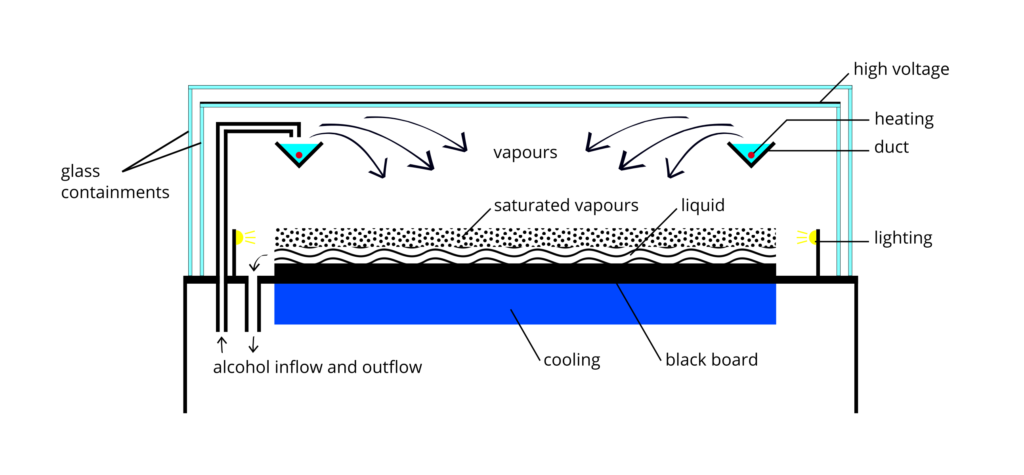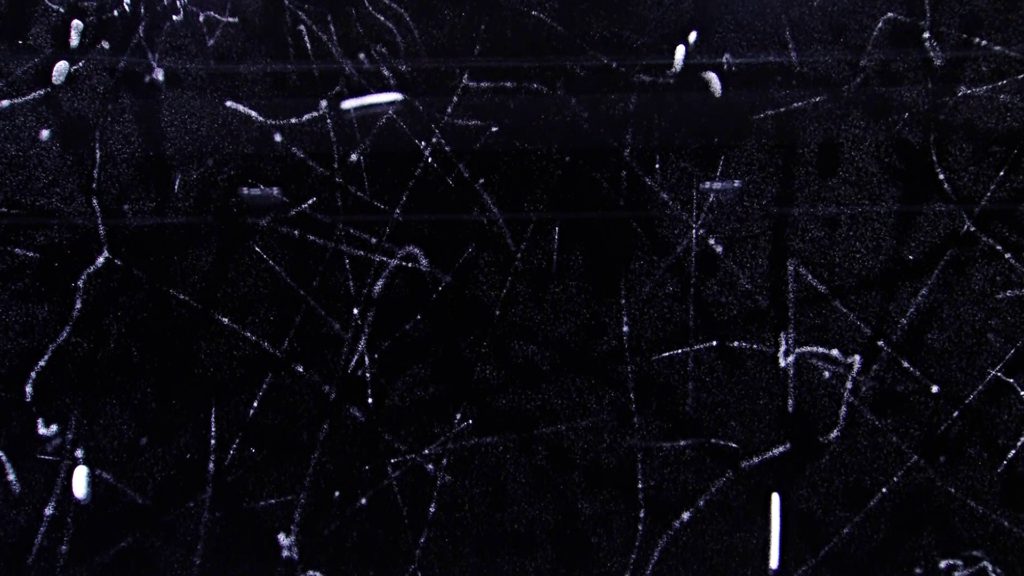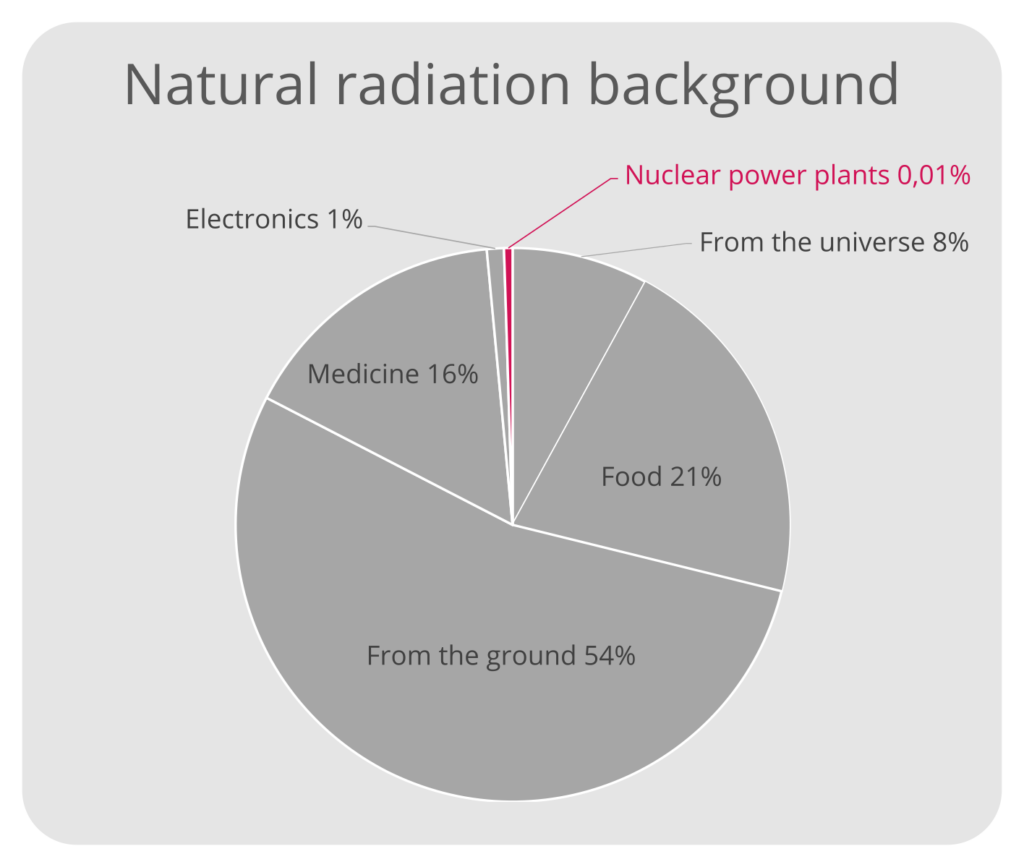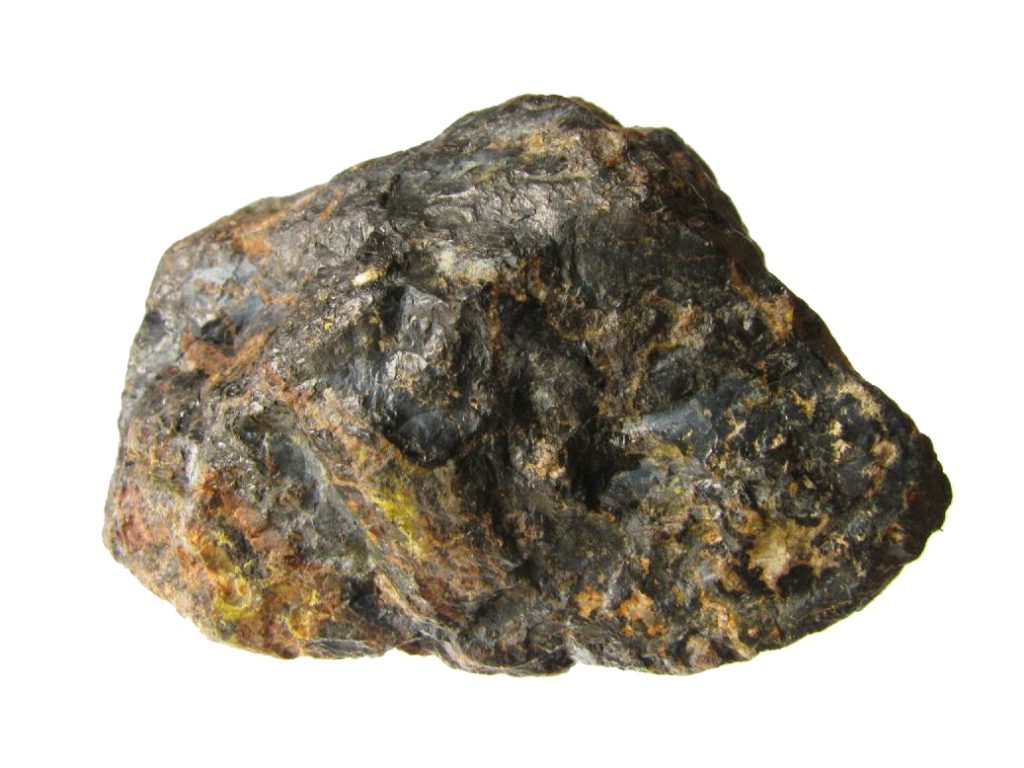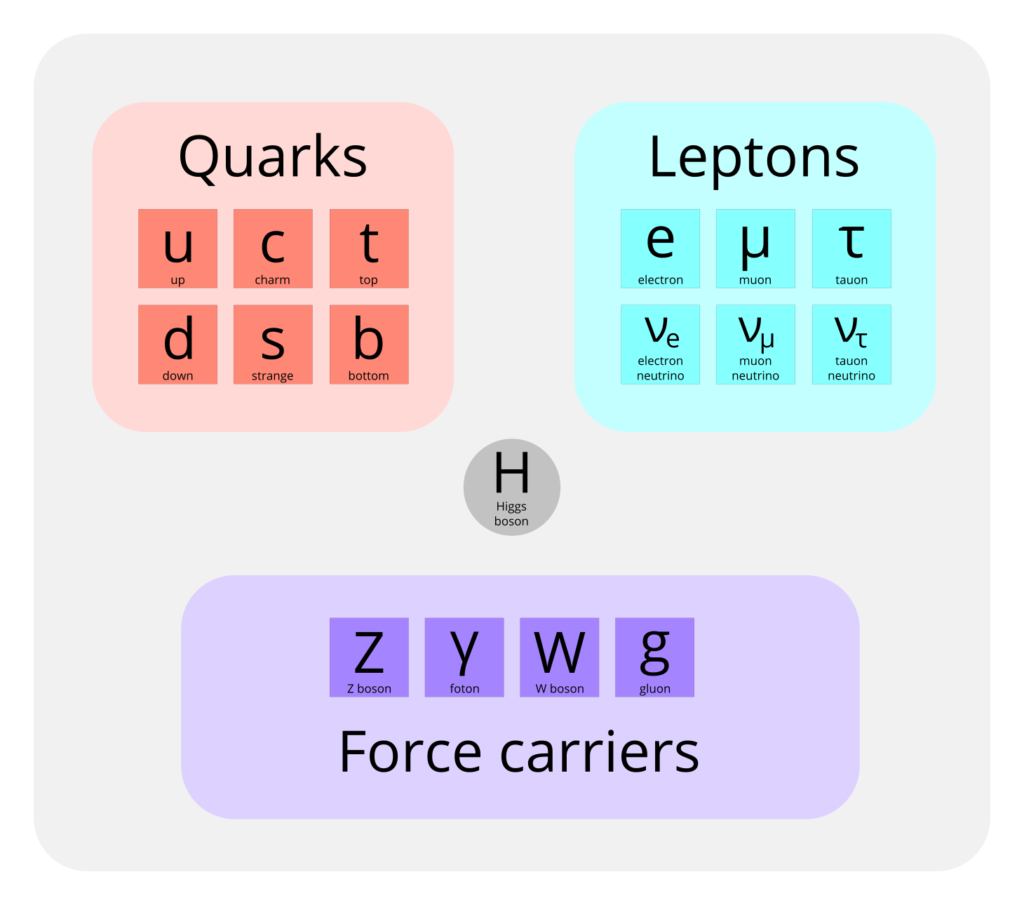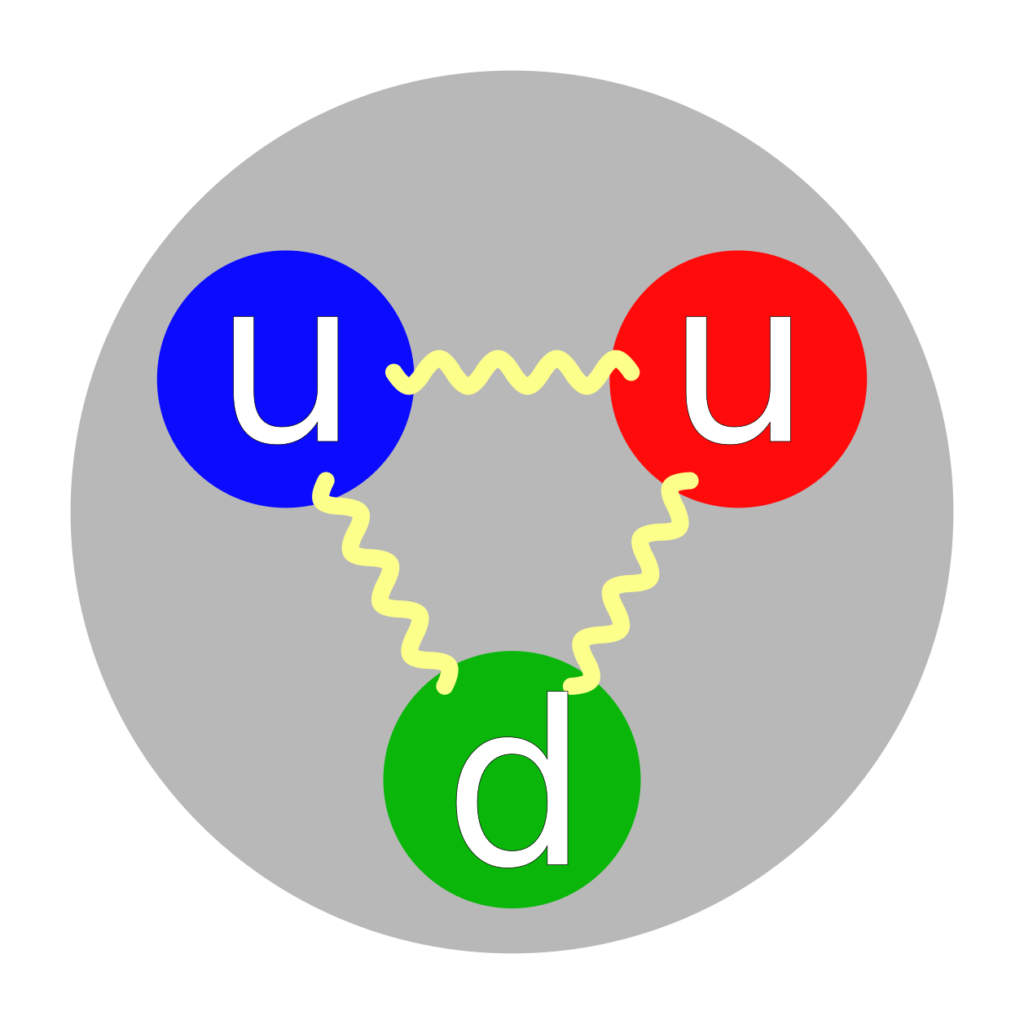What is a cloud chamber?
Cloud chamber, also known as Wilson chamber or diffusion cloud chamber, is a device capable of displaying invisible tracks of ionising radiation, which makes it unique tool for intuitive and fun education of nuclear and particle physics.
How does a cloud chamber work?
The theoretical description of diffusion cloud chambers is basically the theory of phase transitions. Cloud chamber invention is credited to a Scottish physicist Charles Wilson, who studied cloud formation in expansion cloud chambers. (i. e. cloud chambers achieving required condensation conditions by gas expansion). Precipitation of liquid droplets from vapour requires two basic factors. Saturated vapour pressure at given pressure and temperature, and condensation nuclei. Wilson observed that apart from dust or other solid particles, ions can serve as condensation nuclei for droplets. Thus the theoretical basis of cloud chambers was laid down.
Cloud chamber explained
Cloud chambers are devices used to visualise particles of ionising radiation. This radiation originates in decay of radioactive materials. However, particles of ionising radiation are very small and move at high speeds which makes them impossible to see with a naked eye.
The displayed cloud traces are formed due to specific conditions inside a cloud chamber. A layer of supersaturated vapor is created over the black observational area as a result of a temperature gradient. While the observational area is being cooled, in the upper part of the inner space of a cloud chamber – in the duct – isopropyl alcohol is heated. Isopropyl alcohol which evaporates from the duct descends towards the cold observational area. Over its surface it creates a layer of supersaturated vapor approximately 1 cm thick.
If an electrically charged particle flies through a layer of supersaturated vapour of isopropyl alcohol, we see its track in a form of a bright white line. The charged particle causes ionization of molecules of isopropyl alcohol, which act as condensation nuclei. The observed white track is a dense cloud of very small droplets of isopropyl alcohol formed by rapid condensation.
A white track, formed after a passage of a charged particle, contrasts with the black observation area and is clearly visible even with a naked eye. No two cloud tracks are identical and they differ enough to allow us to identify which particle caused it and to determine its properties – sometimes even its origin. The formation of white tracks is analogous to contrails (condensation trails) created by airplanes in the sky. When airplanes fly at high altitudes, the water produced from burning fuel condenses due to low temperature. Resulting water droplets or ice crystals can serve as condensation nuclei for surrounding water vapour making the trails thicker and longer-lasting. Similarly, the saturated vapour in a cloud chamber allows the tracks to last long enough to be easily observed.
In cloud chambers a temperature gradient above a cold surface is used to create a layer of supersaturated vapour (of water, isopropanol or other liquids). Such vapour immediately precipitates into small droplets in presence of condensation nuclei. Charged particles of radiation can provide such an impetus and create cloud tracks visible even by naked eye. This explanation is actually very similar to formation of cloud tracks behind airplanes, which we know from everyday life.
The first cloud chamber was invented and constructed by a Scottish physicist Charles Thomson Rees Wilson. The device was switched on for the first time in 1911 after almost twenty years of development.
In 1927 Charles Thomson Rees Wilson was awarded a Nobel Prize in physics for his method of making the paths of electrically charged particles visible by condensation of vapour.
Observation of ionising radiation particles
A cloud chamber serves for displaying electrically charged particles, which come from different natural sources, such as secondary cosmic radiation, natural radioactive background, or from artificial sources of radiation.
Radioactivity
Radioactivity, also known as radioactive decay is a phenomenon of transformation of the inner structure of atomic nuclei. It is often accompanied by a release of ionizing radiation (alpha, beta or gamma). Radioactivity is a natural phenomenon, which is not caused only by human activity. There are many natural radioactive materials like uranium ore or even bananas!
We can illustrate radioactive decay by a simple analogy. Let’s imagine an obese person. Obesity is not natural for people in general, so he would like to lose some weight. The easiest way how he can achieve that, is to throw away useless fat reserves. The same motivation have the atomic nuclei, which are in a state that is unnatural for them. For example, they may have a high number of neutrons; in other words, they are too big. Such nuclei tend to change their structure by, e. g., getting smaller by alpha particle emission (two protons and two neurons in a helium nucleus), or they change a neutron to a proton, while emitting an electron (beta minus decay).
Although the term radioactivity is mostly associated with nuclear power plants, they form only a tiny fraction of the entire radioactive background. The term radioactive background is used for all radiation we are exposed to when living on Earth. The radiation caused by the nuclear power plants is miniscule, even if we include the nuclear catastrophes like in 1986 in Chernobyl or in 2011 in Fukushima.
The science of the invisible
Many concepts in science are difficult to grasp. Some of them are challenging mathematically; some of them by their complexity. And some of them are just on a completely different scale. Molecules, atoms, subatomic particles – all of these form an extremely useful framework of concepts in science. Why is it that the whole world firmly believes in something that we can never see? There is a strong experimental evidence supporting their existence. Even though, they are impossible to see and even difficult to grasp mentally, particles of all sorts have piled up a huge amount of evidence of their existence. Electricity, radio, electronics, drugs and other chemicals, nuclear power plants, and so much more is possible only because the theories are valid. A crucial problem in the microscopic science has always been visualisation. The most illustrative way to visualise particles is displaying them in the diffusion cloud chambers. Even the smallest elementary particles trigger precipitation of liquid droplets resulting in easily visible cloud tracks. Nowadays, cloud chambers have been replaced in science by electronic instruments, but in terms of hands-on experience, they are unbeatable.
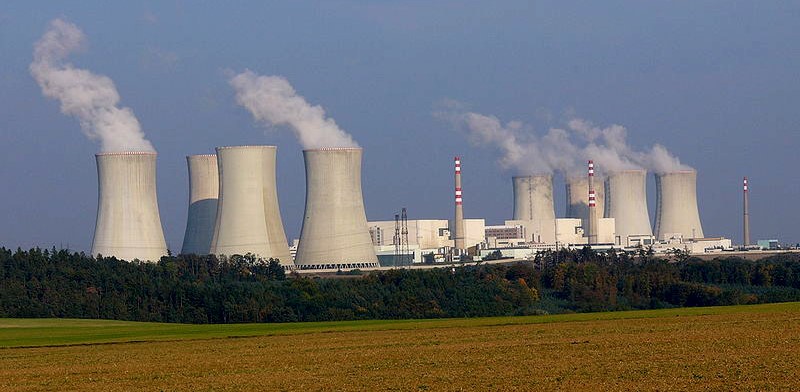
OBSERVABLE PHENOMENA
COMMON
Alpha particles
Alpha particles are groups of two protons and two neutrons i. e. helium nuclei. Alpha particles create shorter and thicker tracks in a cloud chamber. Rays of alpha particles are called alpha radiation. It is the least penetrating kind of radiation; it can be stopped by a sheet of paper or even a few metres of air.
Natural sources of alpha radiation are, for example, uranium, radium or radon. Radon-222 isotope is known for its potential to cumulate in buildings, since it is often naturally released from Earth’s crust. An example of an artificial source of alpha radiation is the americium-241 nuclide of the element americium, which does not exist naturally.
Electrons
Various thin, twisted or straight cloud tracks are formed by electrons. Length and shape of an electron track, depends on the energy of the incoming electron. High energy electrons form straight lines, electrons with lower energy easily change their direction when colliding with molecules of isopropyl alcohol. Electrons displayed in a cloud chamber have their origin in both radioactive transformations that happened on earth, and in secondary cosmic radiation. A ray of electrons is called beta minus radiation. Beta radiation is more intense than alpha radiation; it can be effectively blocked by about 1 mm thick slab of lead.
Positrons
Positron is the first discovered particle of antimatter; it is the antiparticle of an electron. Its track is identical to the electron one. Tracks of these particles can be distinguished only when the cloud chamber is placed into a magnetic field. This causes the tracks of electrons and positrons to bend in the opposite directions due to opposite charge. After all, this is how the positron was observed by Carl Anderson in 1932, who received a Nobel Prize in physics for this discovery. Observed positrons originate from the cosmic radiation or from the natural radioactive decay on Earth. Rays of emitted positrons are called beta plus radiation.
An example of a natural source of beta plus radiation is potassium-40, which happens to be contained in significant amounts in bananas. Consumption of one banana represents a dose equivalent to about 1 % of an average daily dose of natural radiation. We can encounter positrons in medicine as well, specifically in Positron Emission Tomography (PET). It is a diagnostic method, which can visualise only desired tissue. This method is based on introduction of radiopharmaceuticals, into the body of a patient. These radiopharmaceuticals are sources of beta plus radiation, i. e., emitters of positrons. Escaping positrons annihilate with electrons in atoms of human body while creating photons. Consequently, the detector registers these photons and calculates the position of annihilation. It is also possible to identificate annihilation of positron and electron in a cloud chamber from the characteristic appearance of their tracks.
Protons
Thick tracks that often extend over the whole area of a cloud chamber belong to protons, particles that make atomic nuclei. These protons originate in cosmic radiation. Proton tracks can vary in length from the whole width of the chamber all the way to a dot – depending on the angle at which the proton enters the cloud chamber. Protons are also used in medicine, specifically in radiotherapy. In proton therapy accelerated protons are used to irradiate ill tissue; specifically tumours and carcinomas. Proton therapy is an example of a real life application of, originally, a research device. Protons are accelerated using a particle accelerator called cyclotron.
RARE
Muons
Muons are created by interaction of cosmic rays with the atmosphere and penetrate all the way to the Earth’s surface, where we can observe them e. g. in a cloud chamber. We can observe muons in spite of their short lifetime due to time dilation, one of the effects described by the special theory of relativity. Muons move towards ground at a speed close to the speed of light and thus can arrive before they decay.
Thus, if you see a cloud track in a cloud chamber similar to electron, but completely straight due to large speed, it may very well be a muon!
Cosmic-ray air showers
Cosmic radiation are rays of particles coming at high speed from space and hitting the Earth’s atmosphere. There, a creation of secondary cosmic radiation occurs during interaction with molecules of air. We can clearly distinguish cosmic radiation in a cloud chamber, because air showers take form of several cloud tracks oriented in the same direction and arriving at the same time. Particles of cosmic radiation originate mainly in the Sun but also in the interstellar or even intergalactic space.
Delta ray electrons
During a fly-by of a relatively heavy particle with high energy, it is possible to observe tracks of delta ray radiation. These tracks are electrons which are ripped from molecules of isopropyl alcohol by heavy particles like protons. In the cloud chamber, we can then see a straight track of a proton surrounded by thin tracks of electrons. These escaping electrons are called the delta ray electrons.
Indirect observation of gama radiation – Compton scattering
Gamma radiation is not directly visible in a cloud chamber because it is an electromagnetic wave radiation and not a ray of charged particles. However, it is possible to compensate for this partially. By bringing a source of gamma radiation close to the glass of a cloud chamber, electrons are ripped from glass molecules and shot inside the chamber. Consequently, we can observe these electrons in the cloud chamber.
V-shaped double alpha tracks after radon decay
V-shaped tracks are created by two alpha particles, which were emitted within a very small region of space. When radon-220 is present in the cloud chamber, we can see its decay to polonium-216 followed by an almost immediate decay to lead-212. These two decays can be detected as V-shaped tracks of two alpha particles originating from the same point. Radon-220 can be injected into the observation area using the interactive module button.
Radon-220 half-life demonstration
Nuclear half-life is a time interval needed for a half of the particles to decay. In a cloud chamber we can demonstrate this phenomenon using radon-220 and its characteristic V-shaped tracks. After injecting radon-220 into the observation area of the chamber, we observe the maximum frequency of V-shaped tracks. Radon-220 has half-life of one minute. Therefore, after this interval, we observe a half of the initial V-shaped track frequency. If we wait another minute, another half-life interval, we measure a quarter (a half of a half) of the initial frequency. Radon-220 can be injected into the observation area using the interactive module button.
Visualisation of the thorium decay series
Thorium series is one of the four basic decay chains in nature. These chains are known series of decays of common radioactive elements, their transformations to new elements and the radiation they emit.
In a cloud chamber we can observe a part of the thorium series after injection of radon-220. Radon-220 decays to polonium-216 that almost immediately decays to lead-212. Since both of these transformations produce alpha particles, thick, V-shaped tracks are observed. Radon-220 can be injected into the observation area using the interactive module button.
Alpha particles emmited from alpha source
Apart from the background radiation, ionising radiation can also be observed by placing an artificial radiation source into the observation area of the cloud chamber. An example of an artificial source of alpha particles (alpha radiation) is americium-241. Upon insertion of a sample, we can observe outgoing tracks of alpha particles. An artificial source of alpha radiation (americium-241) can be robotically inserted into the observation area using the interactive module.
Electrons emmited from beta source
Apart from the background radiation, ionising radiation can also be observed by placing an artificial radiation source in the observation area of the cloud chamber. An example of a source of electrons (beta radiation) is strontium-90. Upon insertion of a sample, we can observe numerous long thin tracks of electrons resembling a radial fan. An artificial source of electrons (e. g. strontium-90) can be robotically inserted into the observation area using the interactive module.
VERY RARE
Pions
Pions are particles consisting of a pair of elementary particles – quarks “u” and “d”. They always contain one quark and one anti-quark. In a cloud chamber we can observe tracks only of the charged pions. Tracks of pions are very similar to electron tracks and thus are very difficult to distinguish from each other. It is possible only by inspection of the propagation of their tracks. Pions originate in the secondary cosmic radiation that is created in the upper part of atmosphere by interaction of the primary cosmic radiation with molecules of air.
Kaons
Kaons are particles consisting of a pair of elementary particles – one quark “s” and one of the quarks “u” and “d”. They always contain one quark and one anti-quark. In a cloud chamber, we can distinguish kaons from other particles only by observing their decay into pions. Kaons were discovered in cloud chamber photographs in 1947 during cosmic-ray air shower research. They originate in the secondary cosmic radiation that is created in the upper part of atmosphere by interaction of the primary cosmic radiation with molecules of air.
Elastic proton scattering
Elastic proton scattering is one of the rarer phenomena which can be observed in a cloud chamber. It is an interaction of two protons elastically colliding with each other.
Muon decay by weak interaction
In a cloud chamber it is possible to observe a decay by weak interaction of muons into electrons. This decay is clearly visible in the track propagation. A thicker muon track suddenly sharply breaks and becomes thinner – a muon has decayed and a thinner track of an electron is observed. The rest of resulting particles – muon neutrino and electron antineutrino – is not charged and thus cannot be observed in a cloud chamber.
Gamma annihilation
Annihilation occurs when a particle meets its antiparticle. The best-known example is annihilation of an electron and a positron, which creates two gamma photons. In a cloud chamber we observe this phenomenon as two thin tracks which end at the same point. Gamma photons are not observable in a cloud chamber since they do not carry any electrical charge. It is also possible to encounter this phenomenon in the opposite order i. e. a gamma photon decomposes creating an electron-positron pair.
Oh-My-God particle
The first ultra-high energy particle, which had energy comparable with a kinetic energy of a flying football balloon, was observed in 1991. This particle must have come from space, but its exact origin has not been explained yet. The Oh-My-God particle resembles a high-speed proton in its properties. Theoretically it is possible to observe such particle in a cloud chamber, but only a few such particles have been recorded to date.
All particle images above are released under CC-BY-SA 4.0 licence
The standard model of particle physics is a theory which describes three basic forces (interactions) and basic (elementary) particles, which constitute all matter in our universe.
According to this theory, the whole universe is composed of six kinds of leptons and six kinds of quarks. We can describe all their relations by three kinds of interactions – strong, weak and electromagnetic interaction. Although we already know that this theory is not perfect, for example, it does not explain gravitational interaction, it is currently considered as the best model of how the universe works. Electron, mion and tauon have negative elementary charge and thus can be oberved in a cloud chamber. Typically electrons are observed, less often also muons.
Elementary particles
All matter consists of leptons and quarks. Leptons comprise electrons and their heavier counterparts mion and tauon together with their corresponding neutrinos (electron, muon and tauon). Every lepton has its antiparticle; most common are positrons, the antiparticles of electrons. The other particles, quarks, form hadron particles. There are six types of quarks and each one has its antiparticle. An example of a particle composed of quarks, are proton and neutron, which form atomic nuclei. Different particles comprised of quarks are mesons e. g. pions and kaons. Both these mesons were discovered using cloud chambers.
Interactions described by the standard model of particle physics are mediated by intermedial particles – electromagnetic interaction by photon (light, gamma radiation), weak interaction by bosons W+, W– and Z0 (radioactivity) and strong interaction by gluons. An unusual particle is the Higgs boson belonging to so called “Higgs field”, which is responsible for non-zero mass of particles W+, W– and Z0 particles have non zero mass. The Higgs boson was discovered as the last particle of the standard model by the CMS detector at the Large Hadron Collider (LHC) in CERN in 2012.

